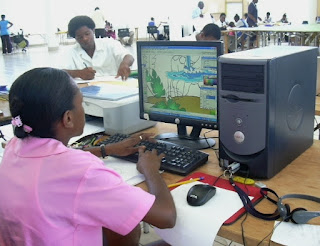Of course there is a need for Teachers.
Teachers are and will always be the vanguard of the teaching and learning process whether they be called "teacher" or "facilitator". Even though research (Vygotsky and Dr. Mitra) has shown that children are able t learn on their own and especially with the use of ICT there is still the need for a human element in the whole equation to complete. Computers and its related technologies cannot validate and give praise as a Teacher can to give the uncertain child the motivation to go ahead when he or she needs it. Also in addition when the child does run into technical glitches there is need for that human element in the form of a "facilitator" to help solve such glitches. So the teacher is needed.
I must agree that ICT does play a key role in enhancing the teaching and learning process across he curriculum and in Education on a whole. It is a known fact that it is a very useful tool for both teachers and students.
As a strong advocate for the integration of technology into the classroom, I have began this integration process in 2004 and have been making some progress. The progress made is not reflected in the physical resource because I still have only one computer and a printer but in the quality of work and students that have been produced over the years using the computer as an additional tool in my Art room. (There is no internet nor any other technolgical resource available). But I have not waited as I am aware that I as the teacher is the most important factor in the equation. In 2005 I was the first teacher to have a student to use the computer as a tool to create Art in the Caribbbean Examinations Council (CXC) CSEC Visual Arts Examinations and since then every year at least two students use this tool to creat Artwork in the Visual Arts exam.
The 'one-computer classroom' has sure been my expereince where students gather around me at the computer as I teach ( using powerpoint and downloaded video clips) and demonstrate using software such as MS Word and MS Publisher and Art software such as Adobe Photoshop. The effort made has produced good results so I xcan say that there is no need for a teacher to wait until he/she gets the ICT ready classrooms and labs but to use but to use his/her teacher artistry skills and be creative in transforming the learning environment into a conducive one using the limited resource so that quality learning can take place. Currently in addition to the desktop computer there are two laptops (both mine) which the students can use.
I must say that it has been challenging because when the students show great interest in wanting to use the computer to create Art, it is done on a one-on-one basis as there is no demonstation device (overhead projector). I also have to give up my breaks and stay back after school and even have classes on Saturdays to achieve the desired outcome.
Penny Adams, first student to use the computer to create Art in CXC Visual Arts exam
Another student using the computer to design a poster
Student using the computer to design and create a logo
Yours truly in a one-on-one teaching session with a student using the 'one computer' method
Student creating Art using the computer
A sports car magazine designed using Adobe photoshop program
So one can see that the combination of the technology and the teacher can and will lead to excellent teaching and learning. Teachers must remember that ICT is not the focus of their programme but that they should use it as an additional tool (as I have been doing) to deliver the content of their subject area because THE TECHNOLOGY CANNOT DELIVER IT WITHOUT US TEACHERS.















.JPG)
